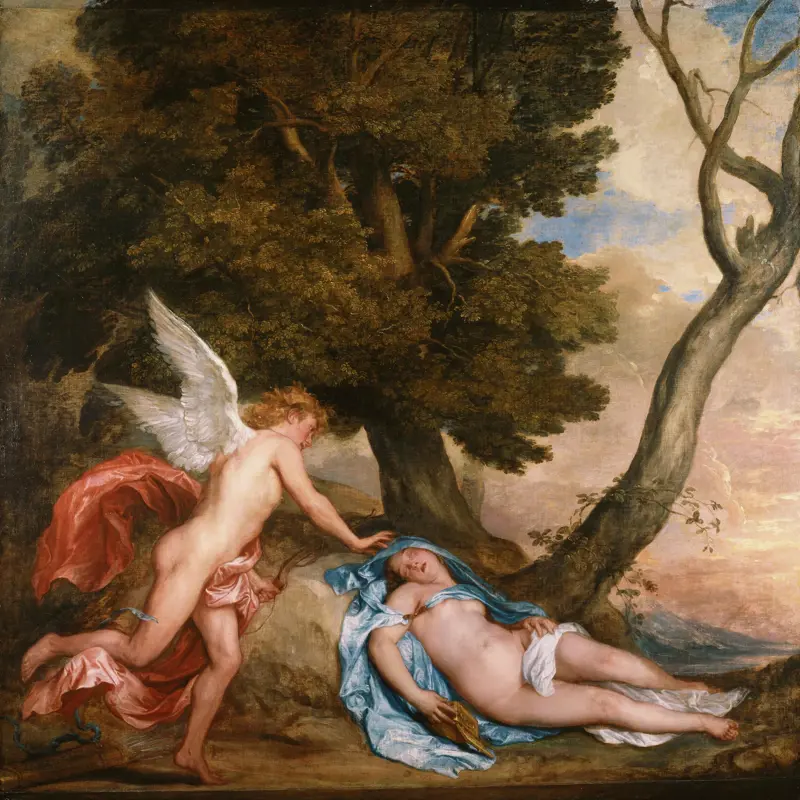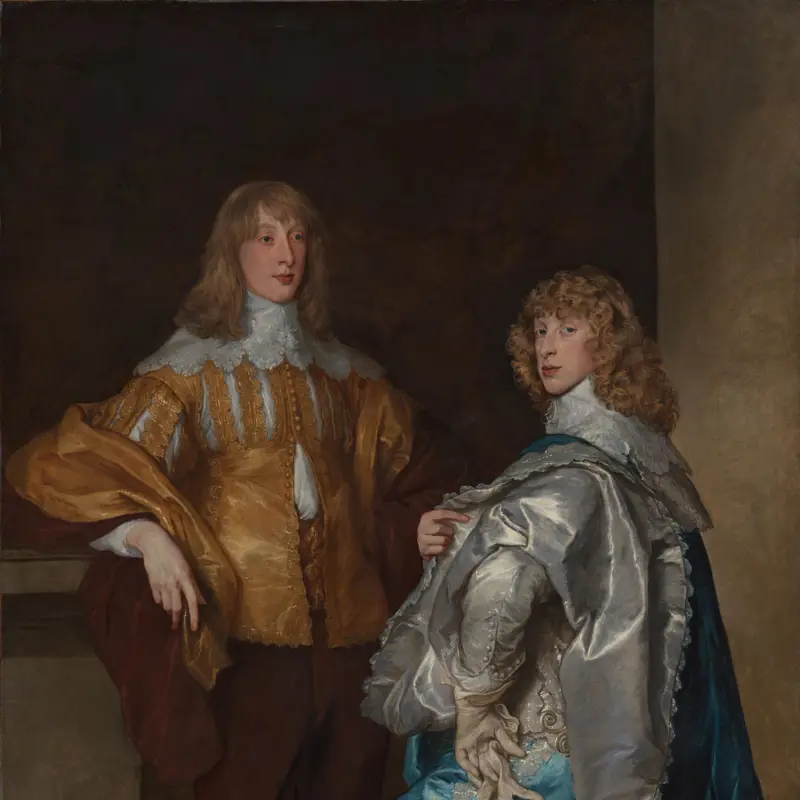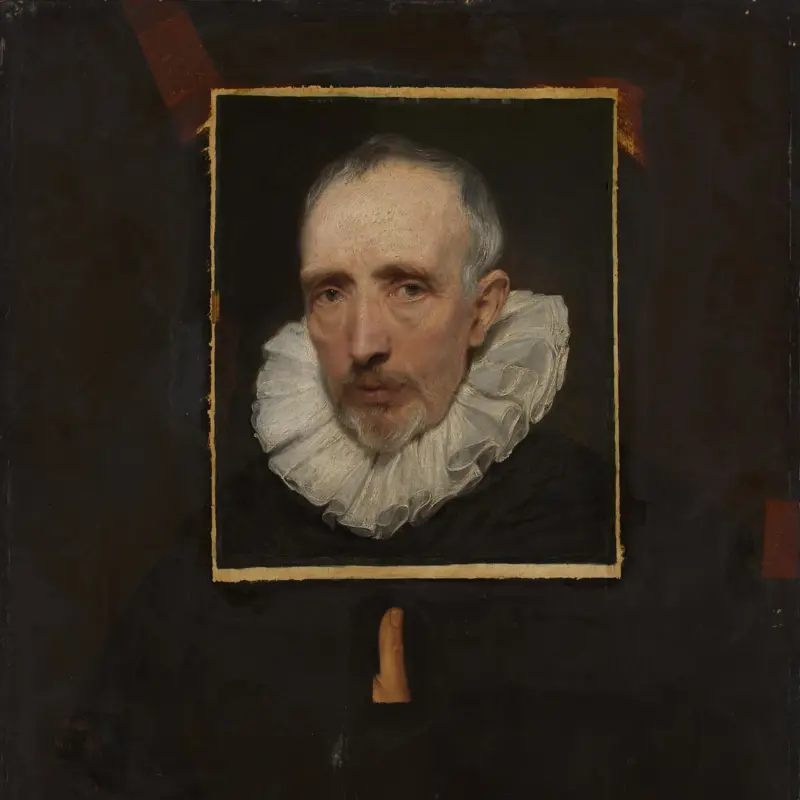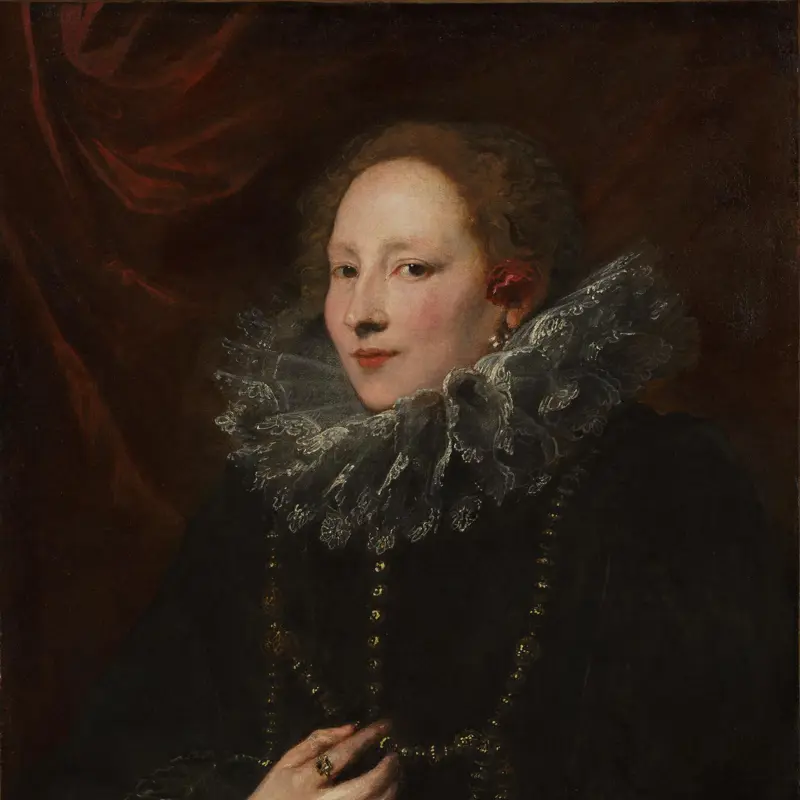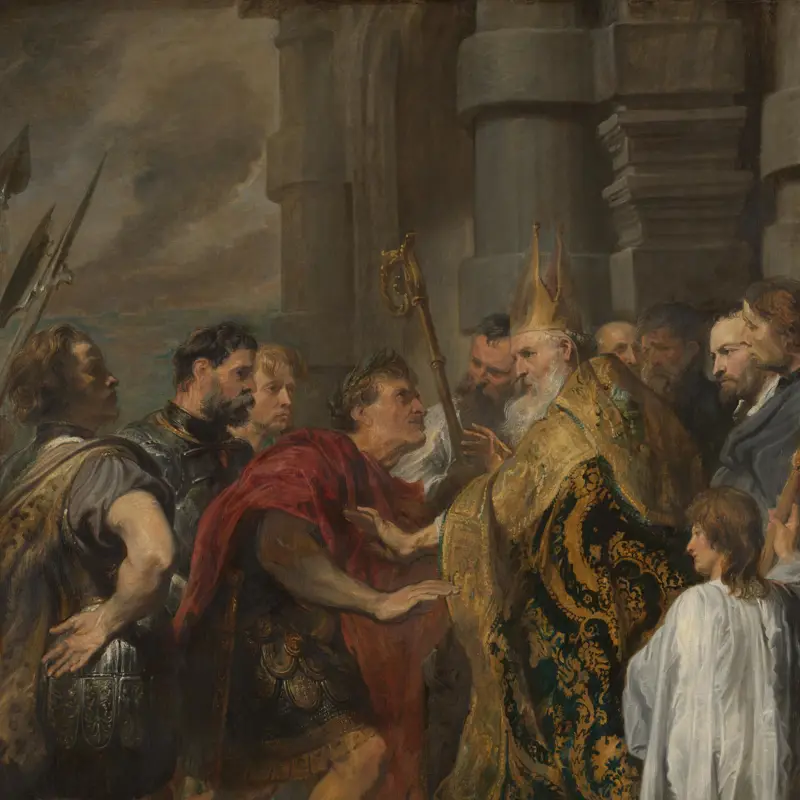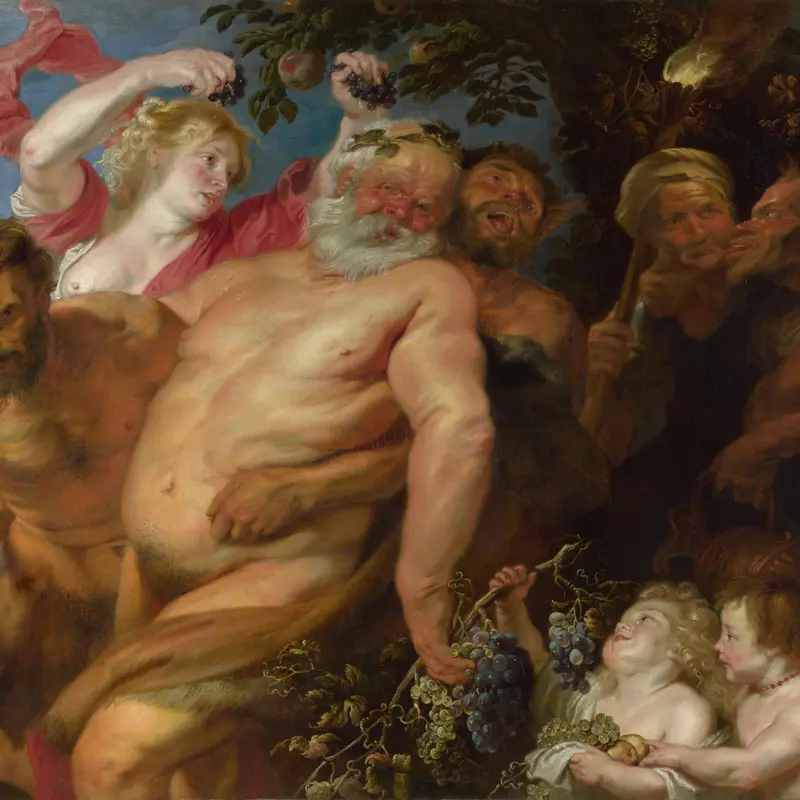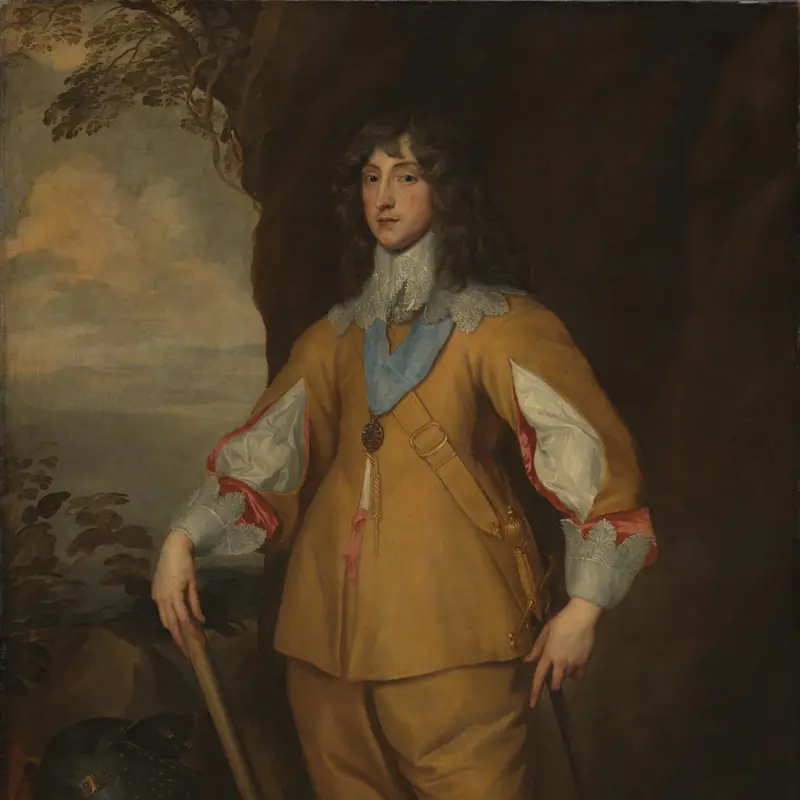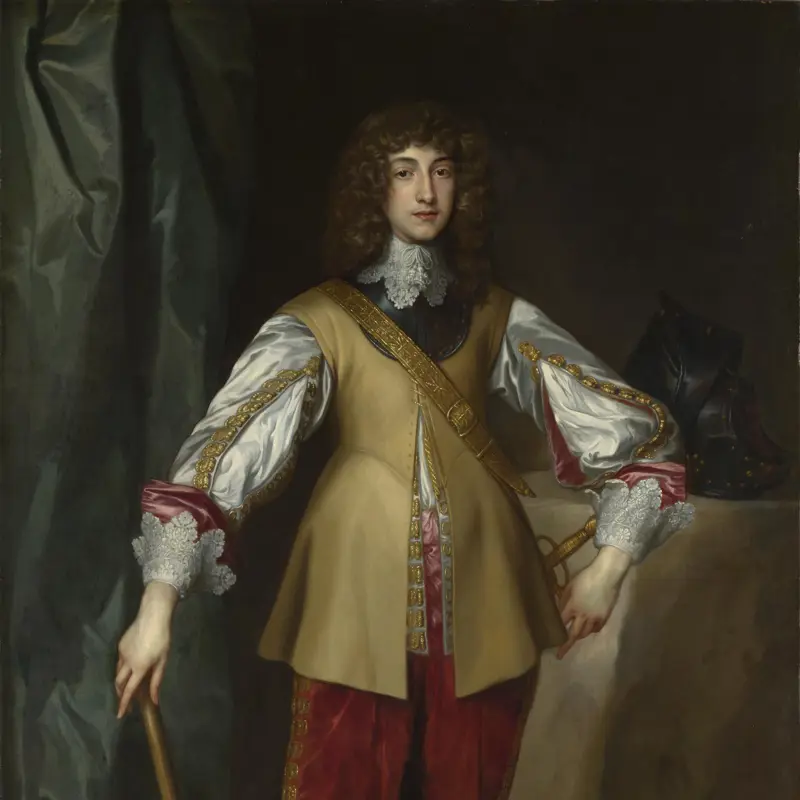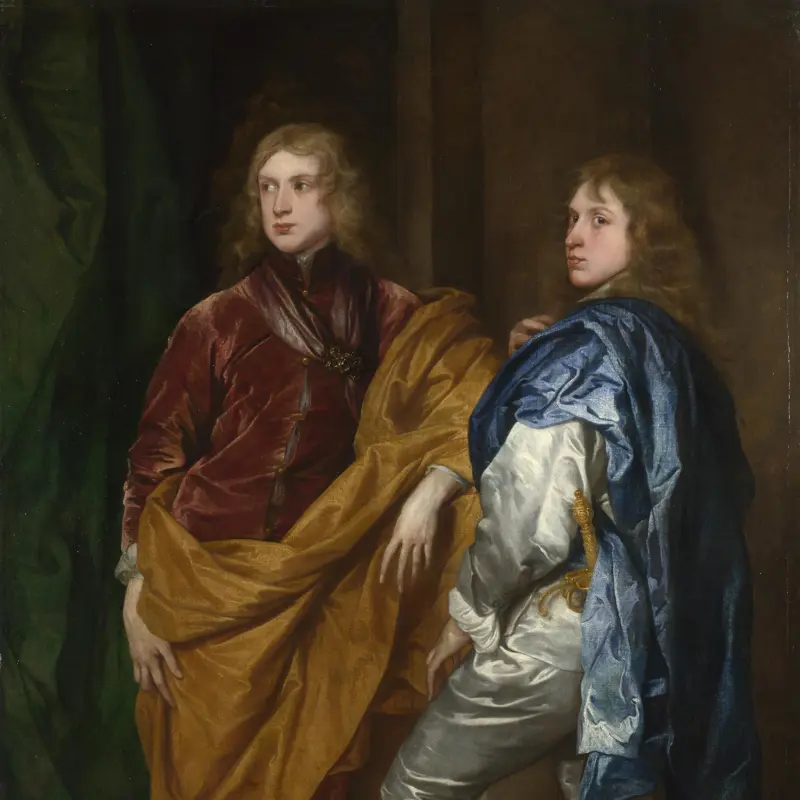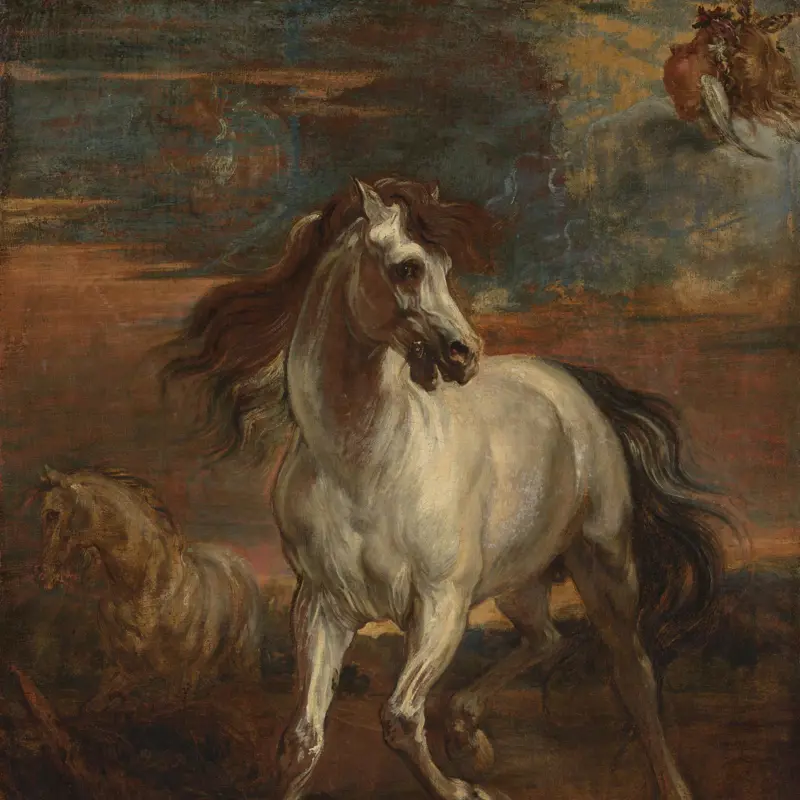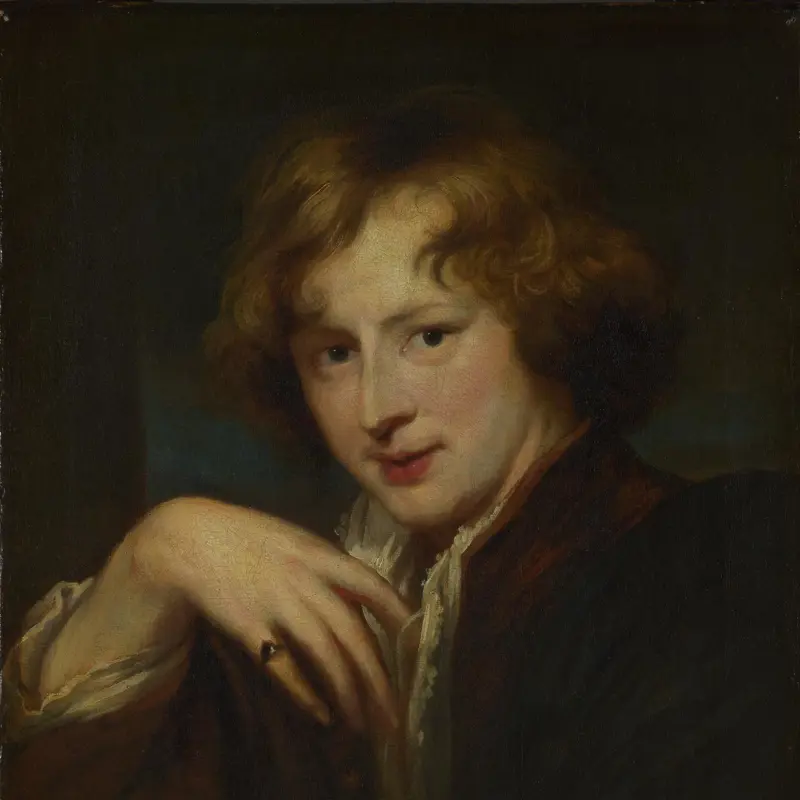Anthony van Dyck, 'Portrait of George Gage with Two Attendants', probably 1621-2
About the work
Overview
The central figure in this work is George Gage (about 1582–1638), an English Catholic, art dealer and political agent in the 1620s, acting for King James I and then Charles I. Both he and Van Dyck lived together in the same house in Rome in 1621 and 1622, and it is highly likely that the painting was made then.
Van Dyck has depicted Gage as an elegant figure negotiating with a dealer in classical antiques. The dealer looks intently at him as he gestures towards the sculpture. While Gage may look diffident, he returns his gaze and seems about to speak. The black figure in the background looks across them and directly at us. He holds the sculpture and is also pointing at it.
We could interpret this in different ways. He may be indicating the significance of the piece, or perhaps he is trying to tempt us as prospective purchasers. Either way, we feel drawn into the negotiations.
Key facts
Details
- Full title
- Portrait of George Gage with Two Attendants
- Artist
- Anthony van Dyck
- Artist dates
- 1599 - 1641
- Date made
- Probably 1621-2
- Medium and support
- Oil on canvas
- Dimensions
- 115 × 113.5 cm
- Acquisition credit
- Bought, 1824
- Inventory number
- NG49
- Location
- Room 21
- Collection
- Main Collection
- Previous owners
- Frame
- 18th-century English Frame
Provenance
Additional information
Text extracted from the ‘Provenance’ section of the catalogue entry in Gregory Martin, ‘National Gallery Catalogues: The Flemish School: circa 1600–circa 1900’, London 1986; for further information, see the full catalogue entry.
Exhibition history
-
2016Van Dyck: The Anatomy of PortraitureThe Frick Collection1 March 2016 - 5 June 2016
-
2016Painters' Paintings: From Freud to Van DyckThe National Gallery (London)23 June 2016 - 4 September 2016
-
2019Van Dyck.Alte Pinakothek (Munich)25 October 2019 - 2 February 2020
Bibliography
-
1795Christie, Manson & Woods, A Catalogue of the Capital, Genuine and Valuable Collection of Pictures, late the Property of… Sir Joshua Reynolds, London, 11 March 1795 - 14 March 1795
-
1823J. Young, A Catalogue of the Celebrated Collection of Pictures of the Late John Julius Angerstein, Esq: Containing a Finished Etching of Every Picture, and Accompanied with Historical and Biographical Notices, London 1823
-
1824P.G. Patmore, British Galleries of Art, London 1824
-
1829
J. Smith, A Catalogue Raisonné of the Works of the Most Eminent Dutch, Flemish, and French Painters: In Which is Included a Short Biographical Notice of the Artists, with a Copious Description of Their Principal Pictures […], 9 vols, London 1829-1842
-
1854G.F. Waagen, Treasures of Art in Great Britain: Being and Account of the Chief Collections of Paintings, Drawings, Sculptures, Illuminated Mss. […], vol. 2, trans. E. Eastlake, London 1854
-
1873C.G.V. Schneevoogt, Catalogue des estampes gravées d'après P.P. Rubens, avec l'indication des collections où se trouvent les tableaux et les gravures, Haarlem 1873
-
1882J. Guiffrey, Antoine van Dyck: Sa vie et son oeuvre, Paris 1882
-
1886M. Rooses, L'œuvre de P. P. Rubens: Histoire et description de ses tableaux et dessins, 5 vols, Antwerp 1886-92
-
1890M. Rooses, L'oeuvre de P. P. Rubens, Antwerp 1886
-
1899A. Graves and W.V. Cronin, A History of the Works of Sir Joshua Reynolds P.R.A., 4 vols, London 1899
-
1900L.H. Cust, Anthony van Dyck: An Historical Study of his Life and Works, London 1900
-
1909E. Schaeffer, Van Dyck: Des Meisters Gemälde, Stuttgart 1909
-
1909F.M. Haberditzl, Kunstgeschichtliche Anzeigen, Vienna 1909
-
1924M. Vaes, 'Le séjour de van Dyck en Italie (mai‑novembre 1621 ‑ automne 1627)', Bulletin de l'Institut Historique Belge de Rome, IV, 1924
-
1931G. Glück, Van Dyck, des Meisters Gemälde, Stuttgart 1931
-
1933G. Glück, Rubens, Van Dyck und ihr Kreis, Vienna 1933
-
1943H.G. Evers, Rubens und sein Werk: Neue Forschungen, Brussels 1943
-
1944L. Puyvelde, 'Van Dyck and Bernini?', The Connoisseur, 1944, pp. 3‑8
-
1945'Editorial: Sir Joshua Reynolds' Collection of Pictures, III', The Burlington Magazine, LXXXVII/512, 1945, pp. 263-73
-
1950L. van Puyvelde, Van Dyck, Brussels 1950
-
1969O. Millar, 'Notes on Three Pictures by van Dyck', The Burlington Magazine, CXI, 1969, pp. 414-8
-
1970G. Martin, The Flemish School, circa 1600-circa 1900, London 1970
-
1973M. Jaffé, [Review] 'National Gallery Catalogues: The Flemish School ca. 1600-ca. 1900 by Gregory Martin; Flemish Paintings and Drawings at 56 Princes Gate London, Addenda by Antoine Seilern', Art Bulletin, vol. 55, no. 3 (Sep.), 1973, pp. 462-4
-
1973J. Harris, 'The Link Between a Roman Second‑Century Sculptor, van Dyck, Inigo Jones and Queen Henrietta Maria', The Burlington Magazine, CXV, 1973, pp. 526-30
-
1973M. Jaffé, 'Review of Gregory Martin's "The Flemish School"', Art Bulletin, 1973
-
1975E. Larsen, La Vie, les ouvrages et les élèves de Van Dyck. Manuscrit inédit des Archives du Louvre. Par un auteur anonyme, Brussels 1975
-
1982O. Millar, Van Dyck in England, London 1982-1983
-
1982C. Brown, Van Dyck, Oxford 1982
-
1982H. Brigstocke and W. Buchanan, William Buchanan and the 19th Century Art Trade: 100 Letters to his Agents in London and Italy, London 1982
-
1984C. Brown, 'Allegory and Symbol in the Work of Anthony van Dyck', in H. Vekeman and J. Müller Hofstede (eds), Wort und Bild in der niederländischen Kunst und Literatur de 16. u. 17. Jahrhunderts, Erftstadt 1984, pp. 123-35
-
1985D. Howarth, Lord Arundel and his Circle, New Haven 1985
-
1986Martin, Gregory, National Gallery Catalogues: The Flemish School, circa 1600 - circa 1900, London 1986
-
1986S.J. Barnes, Van Dyck in Italy, Phd Thesis, New York University 1986
-
1987F. Broun, Sir Joshua Reynolds' Collection of Paintings, Phd Thesis, Princeton University 1987
-
1988E. Larsen, The Paintings of Anthony van Dyck, Freren 1988
-
1988C.M.S. Johns, 'Politics, Nationalism and Friendship in van Dyck's Le Roi À la Ciasse', Zeitschrift für Kunstgeschichte, LI, 1988, pp. 243‑61
-
1990S.J. Barnes, A.K. Wheelock and J. Held, Anthony Van Dyck, New York 1990-1991
-
1991M. Jaffé, 'Van Dyck at the National Gallery of Art', The Burlington Magazine, CXXXIII/1055, 1991, pp. 142‑4
-
1992F. Baudouin et al., De Bruegel à Rubens: L'école de peinture anversoise 1550-1650 (exh. cat. Koninklijk Museum voor Schone Kunsten, 19 December 1992 - 8 March 1993), Antwerp 1992
-
1993S.J. Barnes, 'Van Dyck and George Gage', in D. Howarth (ed.), Art and Patronage in the Caroline Courts. Essays in honour of Sir Oliver Millar, Cambridge 1993, pp. 1-11
-
1994A. White, '[review of] David Howarth (ed.), Art and Patronage in the Caroline Courts. Cambridge: Cambridge University Press, 1993', Renaissance Studies, VIII/1, March 1994, pp. 106-9
-
1994D. Freedberg, 'Van Dyck and Virginio Cesarini: A Contribution to the Study of Van Dyck's Roman Sejourns', in S. Barnes and A. Wheelock (eds), Van Dyck 350, Washington 1994, pp. 153-74
-
1994M. Wilson, Nicholas Lanier: Master of the King's Musick, Aldershot 1994
-
1994E. Goodman-Soellner, 'Woman's Supremacy over Nature: Van Dyck's "Portrait of Elena Grimaldi"', Artibus et historiae, 30, 1994, pp. 129‑43
-
1995C. White, 'Rubens' portrait drawing of Thomas Howard, the second Earl of Arundel’, Burlington Magazine, vol. 137, no. 1106 (May), 1995, pp. 316-9
-
1996H. Mount (ed.), Sir Joshua Reynolds, a Journey to Flanders and Holland, Cambridge 1996
-
1997S.J. Barnes, 'La società genovese nei ritratti di Van Dyck', in P. Boccardo and C. Di Fabio (eds), Pittura Fiamminga in Ligura secoli XIV-XVII, Genoa 1997, pp. 229-58
-
1997D. Howarth, Images of Rule: Art and Politics in the English Renaissance, 1485-1649, Macmillan 1997
-
1998E. Chaney, The Evolution of the Grand Tour: Anglo-Italian Cultural Relations Since the Renaissance, London 1998
-
1999A. Roy, 'The National Gallery van Dycks: Technique and Development', National Gallery Technical Bulletin, XX, 1999, pp. 50‑83
-
1999R. White, 'Van Dyck's Paint Medium', National Gallery Technical Bulletin, XX, 1999, pp. 84-8
-
2000L. Arcangeli, 'Anton van Dyck', in E. Borea and C. Gasparri (eds), L'Idea del Bello: Viaggio per Roma nel Seicento con Giovanni Pietro Bellori, Rome 2000, pp. 305-20
-
2000E.B. Gilman, 'Madagascar on My Mind: The Earl of Arundel and the Arts of Colonization', in P. Erickson and C. Hulse (eds), Early Modern Visual Culture: Representation, Race, and Empire in Renaissance England, Philadelphia 2000
-
2001
C. Baker and T. Henry, The National Gallery: Complete Illustrated Catalogue, London 2001
-
2001E. Chaney and G. Worsdale, The Stuart Portrait: Status and Legacy (exh. cat., Southampton Art Gallery), Southampton 2001
-
2001B.L. Brown (ed.), The Genius of Rome, London 2001
-
2001E. Chaney and G. Worsdale, The Stuart Portrait: Status and Legacy, (exh. cat. Southampton City Art Gallery, 2001), Southampton 2001
-
2004H. Vey et al., Van Dyck: A Complete Catalogue of the Paintings, New Haven 2004
-
2004M.G. Bernardini, Anton van Dyck: Riflessi italiani, Milan 2004
-
2011G. Martin, Rubens in London: Art and Diplomacy, London 2011
-
2014A. Amendola, 'Dentro e fuori il palazzo. Tessuti e arazzi come specchio dello status sociale', in C. Volpi and A. Rodolfo (eds), Vestire i palazzi: Stoffe, tessuti e parati negli arredi e nell'arte del Barocco, Vatican City, 2014, pp. 91-110
-
2016S. Alsteens and A. Eaker, Van Dyck: The Anatomy of Portraiture, New Haven and London 2016
-
2016A. Robbins, Painters' Paintings: From Freud to Van Dyck (exh. cat., The National Gallery, London), London 2016
-
2017H. Maddicott, '"George Gage with Two Attendants" by Anthony Van Dyck (1599–1641): Identification and Provenance', British Art Journal, XVIII/2, Autumn 2017, pp. 27-31
-
2019B. Maaz and M. Neumeister, Van Dyck: Gemälde von Anthonis van Dyck, Munich 2019-2020
-
2021J. Peacock, Picturing Courtiers and Nobles from Castiglione to Van Dyck: Self Representation by Early Modern Elites, New York 2021
-
2021C. White, Anthony van Dyck & the Art of Portraiture, London 2021
About this record
If you know more about this work or have spotted an error, please contact us. Please note that exhibition histories are listed from 2009 onwards. Bibliographies may not be complete; more comprehensive information is available in the National Gallery Library.


